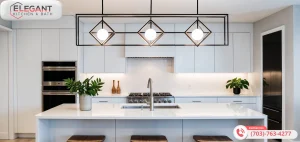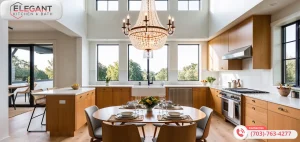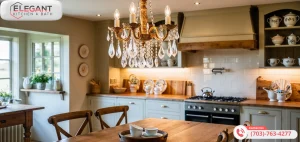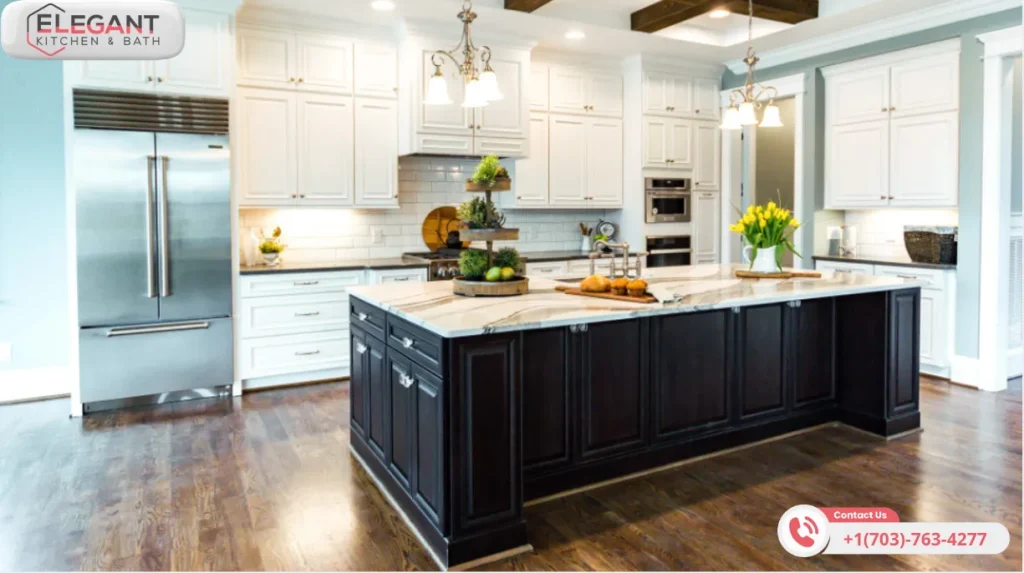Selecting the ideal chandelier lighting for your kitchen can be challenging, especially with numerous options available on platforms like Wayfair. A common problem many face is finding a fixture that combines style and functionality. This article will guide readers through assessing their kitchen space, exploring various chandelier styles, and identifying the right size for their space. Engaging with this content will help resolve the confusion surrounding chandelier selection, ensuring a perfect blend of aesthetics and practicality while enhancing the kitchen’s overall ambiance.

Key Takeaways
- Assess kitchen dimensions for a harmonious chandelier fit
- Consider ceiling height when selecting chandelier design and placement
- Identify key lighting areas to enhance kitchen functionality
- Choose styles that complement cabinetry and overall kitchen design
- Ensure proper installation and maintenance for long-lasting chandelier performance
Assess Your Kitchen Space and Layout
To select the ideal chandelier lighting for your kitchen, it is vital to assess your kitchen space and layout. Start by measuring your kitchen’s dimensions to ensure the chandelier fits harmoniously within the cabinetry and overall design scheme. Identify key illumination areas that require focused lighting, and consider ceiling height and architectural features, as these will influence the chandelier‘s design and placement.
Measure Your Kitchen’s Dimensions
Measuring the kitchen’s dimensions is a critical first step in selecting the right chandelier lighting. Proper measurements ensure that the chosen kitchen light fixtures over the table complement the dining area without overwhelming the space. For instance, a rectangle dining light should be proportionate to the table size and the room, allowing for adequate clearance above the table while maintaining a harmonious look with surrounding cabinetry made of wood.
In addition to width and length, ceiling height significantly influences the chandelier‘s design and placement. A room with high ceilings might necessitate pendant lights that hang lower, creating an inviting ambiance while still being efficient with color temperature for meal preparation and dining. By accurately measuring these dimensions, one can find the perfect balance of style and functionality in kitchen lighting, ensuring it enhances both the space and the overall design aesthetic.
Identify Key Illumination Areas
Identifying key illumination areas in the kitchen is essential for selecting the right chandeliers. These areas typically include the kitchen table, countertops, and any space used for food preparation. A well-placed light fixture can enhance functionality, especially over the kitchen table, where dining or socializing often occurs. Choosing a farmhouse dining light that complements both style and brightness can significantly elevate the kitchen’s atmosphere.
In addition to the dining area, it is equally important to consider the overall layout and design elements, such as ceiling height and architectural features. For example, a spacious lobby may benefit from striking kitchen table chandeliers that provide ample light without overwhelming the aesthetics. By focusing on these key areas, homeowners can create an inviting and visually appealing space that meets their cooking and entertaining needs:
- Kitchen table and dining area
- Countertops for meal preparation
- Cocktail or coffee serving areas
- Feature spaces like islands or peninsulas
Consider Ceiling Height and Architectural Features
When selecting chandelier lighting, ceiling height and architectural features play a crucial role in determining the best light fixtures over the dining table. For kitchens with high ceilings, a larger chandelier can add a dramatic effect, while also ensuring adequate illumination over the dining space. In contrast, for smaller kitchens or lower ceilings, a more compact design is advisable to maintain proportion and avoid overwhelming the area, facilitating the effective use of energy-efficient compact fluorescent lamps for optimal brightness.
Architectural features, such as beams or decorative molding, can enhance the visual appeal of a chandelier while influencing placement. For instance, positioning a dining table ceiling light to align with these elements can create a cohesive look within the kitchen’s décor. Additionally, selecting a retail chandelier that contrasts or complements cabinetry materials, such as wood, works effectively to unify the design and enhance the kitchen’s overall ambiance.
Explore Chandelier Styles That Suit Your Kitchen
Choosing the right chandelier involves exploring various styles that complement the kitchen’s design and functionality. Traditional designs often feature intricate details, while modern and contemporary options embrace sleek lines and innovative materials. Rustic and industrial styles bring warmth and character, and transitional or eclectic selections offer versatility. Each style’s unique attributes, from lantern shapes to dimmer capabilities, enhance specific areas, making them essential considerations in creating an inviting room atmosphere.
Discover Traditional Designs
Traditional designs for chandelier lighting can significantly enhance a kitchen’s atmosphere. A farmhouse dining chandelier, for instance, often utilizes iron and gold leaf finishes to create a warm and inviting look. These materials not only add visual interest but also ensure durability, making them a practical choice for any home improvement project.
Incorporating traditional chandeliers into kitchen spaces allows homeowners to integrate rustic charm with modern functionality. For example, chandeliers with a combination of iron elements and gold leaf accents can complement wooden cabinetry beautifully, creating a cohesive design. This approach not only highlights the beauty of the chandelier but also serves to illuminate key areas, such as the dining table or kitchen wall features, effectively meeting both aesthetic and practical needs.
Consider Modern and Contemporary Options
Modern and contemporary chandelier lighting for kitchens often features clean lines, geometric shapes, and innovative materials. Options such as silver pendant lights can add a sleek, polished look that enhances the overall aesthetic of the dining room. These fixtures not only provide illumination but also serve as stylish focal points, making them a great choice for homeowners looking to update their kitchen’s design.
In addition to pendant lights, incorporating sconce lighting can further elevate the kitchen’s ambiance. The right combination of chandelier and sconce lights allows for versatile lighting solutions that cater to various activities, from meal preparation to casual dining. Selecting modern designs in muted or metallic finishes ensures that the space remains both functional and visually appealing, meeting the needs of modern living.
Look Into Rustic and Industrial Styles
Rustic and industrial styles are ideal for homeowners looking to create an elegant kitchen that exudes warmth and character. Chandeliers crafted from materials like brass, reclaimed wood, and iron can beautifully enhance the kitchen’s aesthetic while providing functional lighting. Home Depot kitchen chandeliers often showcase these styles, offering a range of options that blend seamlessly with various cabinetry finishes and overall design themes.
Incorporating rustic or industrial chandeliers allows for a dramatic focal point within the kitchen space. These fixtures can feature unique designs, combining vintage elements with modern functionality to illuminate areas like the dining table or kitchen island effectively. The use of brass accents in these light fixtures not only adds visual interest but also ensures durability, making them a practical choice for any busy kitchen.
Evaluate Transitional and Eclectic Selections
Transitional and eclectic chandelier selections provide homeowners with the flexibility to merge different design elements, creating a unique kitchen atmosphere. These styles blend traditional craftsmanship with modern aesthetics, allowing for a seamless integration in spaces that feature diverse cabinetry finishes. For example, a chandelier that incorporates crystal accents within a sleek metal frame can bridge the gap between classic elegance and contemporary minimalism, enhancing the overall kitchen design.
Choosing transitional or eclectic chandeliers empowers homeowners to express personal style while maintaining functionality. Lighting fixtures in these categories often offer versatility, allowing them to fit well with various kitchen layouts and decor themes. For instance, a mixed-material chandelier that combines wood and metal not only illuminates key areas but also complements wooden cabinetry, addressing the need for both style and effective lighting in the kitchen.

Choose the Right Size and Proportion
Choosing the right size and proportion for a chandelier is essential in achieving a balanced kitchen design. This section will cover how to calculate the ideal fixture size while ensuring proportional balance with kitchen elements. Additionally, homeowners will learn how to select a chandelier that complements their space, enhancing both functionality and aesthetic appeal.
Calculate the Ideal Fixture Size
Calculating the ideal fixture size for a chandelier is a straightforward process that can significantly enhance the kitchen’s overall appearance. A common rule is to add the room‘s length and width in feet to determine the chandelier‘s diameter in inches. For example, if the kitchen measures 12 feet by 16 feet, the ideal chandelier size would be 28 inches in diameter (12 + 16 = 28). This calculation helps ensure the chosen chandelier will be proportional to the kitchen space while providing adequate illumination.
In addition to the diameter, considering the height at which the chandelier will hang is also essential. A general guideline suggests that the bottom of the fixture should be approximately 30 to 36 inches above the dining table or counter to ensure clear sight lines and functionality. Maintaining this height allows the chandelier to illuminate effectively without obstructing the view of the kitchen and its features. By following these sizing tips, homeowners can achieve not only a stylish look but also a well-lit and functional kitchen space:
Ensure Proportional Balance With Kitchen Elements
Ensuring proportional balance with kitchen elements is essential when selecting chandelier lighting. Homeowners should consider the scale of the chandelier in relation to other features, such as cabinetry, countertops, and furniture. A well-chosen chandelier will harmonize with these elements, providing a cohesive look that enhances both the beauty and functionality of the kitchen space.
To achieve this balance, it is advisable to maintain a consistent style that complements cabinetry materials and finishes. For instance, a modern chandelier made of sleek metal can beautifully contrast with wooden cabinetry, while also being sized appropriately to match the dimensions of the dining table or island below. Maintaining this proportionality not only improves aesthetic appeal but also ensures effective lighting for the kitchen’s various functions:
Select a Chandelier That Complements Your Space
Selecting a chandelier that complements the kitchen space involves careful consideration of style, materials, and color. Homeowners should look for fixtures that resonate with the kitchen’s cabinetry and overall design theme. For instance, a modern chandelier featuring sleek metal finishes can harmonize beautifully with wooden cabinets, achieving a coherent visual appeal while enhancing the kitchen’s functionality.
Additionally, the size and design of the chandelier should reflect the kitchen’s dimensions and layout. A well-proportioned chandelier provides not only adequate illumination but also acts as a focal point that draws the eye without overwhelming the space. By matching the chandelier’s design elements with the existing decor, homeowners can create an inviting atmosphere that meets both aesthetic and practical needs.
Decide on Lighting Functionality and Features
To select the ideal chandelier lighting for a kitchen, homeowners should first determine their specific lighting needs, which can vary based on tasks and desired ambiance. Opting for dimmable options can enhance flexibility, allowing for mood adjustments as required. Energy efficiency is also important, as it contributes to long-term savings, while adjustable fixtures offer versatility, accommodating different activities and layouts. Each of these features plays a crucial role in enhancing both functionality and aesthetics within the kitchen space.
Determine Your Lighting Needs
Determining lighting needs is a fundamental step in selecting chandelier lighting for the kitchen. Homeowners should assess the various activities that take place in the space, such as meal preparation, dining, and entertaining. Each of these tasks may require different levels of brightness, guiding the choice of fixture and its features. For instance, bright, focused lighting is ideal for countertops where cooking occurs, while softer lighting can enhance the ambiance during social gatherings at the dining table.
In addition to task-specific needs, homeowners should consider their desire for ambiance control within the kitchen. Dimmable chandeliers provide flexibility, allowing for adjustments based on the time of day or occasion. Furthermore, integrating energy-efficient options promotes sustainability while reducing electricity costs. By evaluating these lighting requirements, homeowners can make informed decisions that elevate both functionality and aesthetics in their kitchen space:
Opt for Dimmable Options
Opting for dimmable chandelier lighting offers homeowners greater control over their kitchen’s ambiance. Dimmable fixtures allow adjustments in brightness, making it possible to create a vibrant atmosphere during meal preparation or a soft glow for intimate dining experiences. This flexibility is particularly beneficial in multifunctional spaces, where lighting needs may shift throughout the day.
Additionally, dimmable options contribute to energy efficiency. By reducing brightness when full illumination isn’t necessary, homeowners can lower energy consumption and extend the lifespan of their light fixtures. This adaptation aligns with modern priorities of sustainability and cost-effectiveness, ensuring that the selected chandelier not only enhances the kitchen’s aesthetic but also promotes long-term savings.
Consider Energy Efficiency
Considering energy efficiency when selecting chandelier lighting for the kitchen is a practical approach that benefits both the environment and the homeowner’s budget. Opting for LED chandeliers instead of traditional incandescent bulbs can lead to significant savings on electricity bills while providing bright, reliable illumination. This choice not only illuminates the kitchen effectively but also reduces the frequency of bulb replacements, enhancing overall convenience in maintenance.
Moreover, integrating smart technology into chandelier lighting adds another layer of energy efficiency. Homeowners can utilize programmable dimmers and smart switches to control the brightness and timing of their lighting. This capability allows for personalized adjustments based on daily routines, ensuring that the kitchen is only lit when needed. By prioritizing energy-efficient options, individuals can create a striking kitchen aesthetic while embracing sustainable living practices.
Explore Adjustable Fixtures
Adjustable fixtures offer a practical solution for homeowners looking to enhance the functionality of their kitchen lighting. These versatile chandeliers can be modified to suit various tasks and activities, providing adequate illumination whether cooking, dining, or entertaining. By choosing adjustable fixtures, individuals can tailor the lighting to their specific needs, creating an environment that promotes both productivity and comfort.
Moreover, adjustable chandeliers contribute to the overall aesthetic appeal of the kitchen. By allowing homeowners to change the height or direction of the light, these fixtures can adapt to changing styles and preferences over time. This flexibility ensures that the chandelier not only meets immediate lighting needs but also complements the evolving design of the kitchen space, making it a valuable investment for long-term use.

Coordinate With Your Kitchen Décor and Color Scheme
To achieve a cohesive look in the kitchen, homeowners should focus on three key aspects: matching materials and finishes, complementing the color palette, and blending styles harmoniously. Matching materials ensures that the chandelier seamlessly integrates with existing cabinetry and furnishings, while a complementary color palette enhances the overall aesthetic. Additionally, blending different styles allows for an inviting atmosphere that reflects personal tastes and preferences.
Match Materials and Finishes
When selecting chandelier lighting, matching materials and finishes with cabinetry and furnishings is key to achieving a harmonious kitchen design. For instance, a brass chandelier complements wooden cabinets beautifully, enhancing the overall aesthetic without clashing. This attention to detail not only elevates the visual appeal but also creates a cohesive look that resonates with the kitchen’s style.
Homeowners should also consider the finish of their chandeliers, as selecting matte or polished options can significantly impact the kitchen’s atmosphere. A matte finish may exude a more contemporary feel, while a polished metal looks elegant and classic. By ensuring that the materials and finishes of the chandelier align with the existing décor, homeowners can create a unified space that reflects their personal taste while meeting practical lighting needs.
Complement Your Color Palette
Complementing the color palette of a kitchen is vital when selecting chandelier lighting. Homeowners should consider the existing colors in cabinetry, countertops, and wall finishes to ensure the chosen chandelier enhances the overall aesthetic. For instance, a chandelier with brushed nickel accents can harmonize well with cool-toned kitchens, while warm-toned fixtures like antique brass can effectively complement rich wood cabinetry.
Additionally, coordinating the chandelier‘s color with other décor elements can create a cohesive design. Selecting a light fixture that mirrors the hues of decorative accents, such as dishes or artwork, can establish a unified look. Attention to these details ensures that the chandelier not only illuminates but also contributes positively to the kitchen’s visual appeal:
- Identify existing cabinet and countertop colors.
- Choose fixture finishes that align with your palette.
- Reflect shades of decorative items in the chandelier‘s design.
Blend Styles Harmoniously
Blending styles harmoniously in kitchen chandelier lighting involves careful consideration of the existing elements within the space. Homeowners can create a cohesive design by selecting chandeliers that reflect a mix of traditional and modern influences, ensuring that each piece complements the overall decor. For instance, a modern chandelier with rustic accents can enhance both sleek cabinetry and vintage decor, bringing together diverse styles into a unified look.
Additionally, incorporating various materials and finishes allows for style blending that resonates with personal tastes. A brass chandelier with glass elements can juxtapose beautifully against wooden cabinetry, maintaining a sophisticated aesthetic while still allowing unique design elements to shine. This approach not only enhances functionality in lighting but also elevates the kitchen’s ambiance, ensuring it becomes an inviting space for both cooking and entertaining.
Prepare for Installation and Maintenance
Proper preparation for installing chandelier lighting is essential to achieving a beautiful kitchen ambiance. Homeowners should first plan for electrical requirements to ensure adequate power supply. Arranging for professional installation guarantees safety and optimal placement. Finally, learning maintenance and care tips will help keep the chandelier in excellent condition, contributing to its long-term performance and aesthetic appeal.
Plan for Electrical Requirements
Planning for electrical requirements is a key step when selecting chandelier lighting for the kitchen. Homeowners should assess the existing electrical setup to confirm it can support the new chandelier, particularly regarding wattage and voltage. This evaluation ensures compatibility with energy-efficient LED options, allowing homeowners to enjoy lower energy costs while maintaining adequate brightness within the kitchen.
It is also advisable to consult a licensed electrician for any adjustments needed in the wiring or circuitry. Professional guidance can prevent safety issues and ensure that the chandelier is installed securely and effectively. This proactive planning mitigates potential disruptions and ensures that the chosen lighting enhances both aesthetic appeal and functionality in the kitchen:
Arrange Professional Installation
Arranging for professional installation of chandelier lighting is a crucial step in achieving an effective and visually appealing kitchen lighting solution. A licensed electrician brings expertise in assessing the kitchen’s electrical system and ensuring compatibility with the new chandelier. This professional oversight minimizes risks associated with improper installation, such as electrical hazards, and guarantees optimal placement for maximum illumination.
Additionally, professional installation can offer design insights tailored to the kitchen’s layout and cabinetry. Electricians can provide recommendations on chandelier height and placement, ensuring the fixture not only illuminates key areas effectively but also enhances the kitchen’s overall aesthetic. Such tailored guidance often leads to a seamless integration of the lighting fixture, creating a harmonious look that meets both functionality and style needs.
Learn Maintenance and Care Tips
Learning how to maintain chandelier lighting is vital to prolong its lifespan and ensure it remains an attractive feature in the kitchen. Regular dusting with a gentle cloth will prevent the accumulation of dirt and keep the chandelier‘s finish looking fresh. For heavier cleaning, using a solution of mild soap and water can help revitalise the material without damaging it. Homeowners should also check and replace any outdated bulbs with energy-efficient options to maintain optimal brightness in the kitchen.
In addition to cleaning, performing routine inspections can help identify potential issues early. Homeowners should ensure that all electrical connections are secure and the fixture is securely mounted. If any problems are detected, it is advisable to consult a professional electrician who can safely address the issue. Taking these steps can help homeowners enjoy beautiful and functional chandelier lighting in their kitchen for years to come:
- Dust regularly with a gentle cloth.
- Use a mild soap and water solution for heavier cleaning.
- Replace outdated bulbs with energy-efficient options.
- Inspect electrical connections and fixture mounting periodically.
- Consult a professional electrician for any issues.

How to Select the Ideal Chandelier Lighting for Your Kitchen?
At Elegant Kitchen and Bath, we understand the importance of choosing the perfect chandelier lighting for your kitchen. Here are some key considerations to help you select the ideal fixture:
Size and Scale
When choosing a kitchen chandelier lighting, consider the size of your space. A general rule is to add the room’s length and width in feet, then convert to inches for the chandelier’s diameter. For example, a 10×12 foot room would suit a 22-inch wide chandelier.
Style and Design
Modern chandeliers can range from sleek and minimalist to bold and artistic. Consider your kitchen’s overall design theme when selecting a style. A linear chandelier works well over rectangular islands or dining tables, while a round chandelier complements square spaces.
Lighting Needs
Assess your kitchen’s lighting requirements. Chandeliers can provide ambient or task lighting, depending on their design and placement. For optimal illumination, combine your chandelier with other lighting sources like recessed lights or under-cabinet fixtures.
Frequently Asked Questions for Chandelier Lighting
What types of chandeliers work best in kitchens?
Kitchen chandelier lighting comes in various styles, from traditional crystal to modern chandeliers. Linear chandeliers are popular for islands, while dining room chandeliers can work well in eat-in kitchens. Choose a style that complements your kitchen’s design while providing adequate illumination for cooking and entertaining.
How high should I hang my kitchen chandelier?
The ideal height for a chandelier in the kitchen depends on its location. Over an island or table, hang it 30-36 inches above the surface. In open areas, ensure at least 7 feet of clearance from the floor. Proper height ensures optimal lighting and prevents accidents in this busy space.
Can I use a dining room chandelier in my kitchen?
Absolutely! A dining room chandelier can work beautifully in a kitchen, especially in eat-in areas. When selecting, consider the scale and style of your kitchen. Choose a fixture that complements your kitchen’s design while providing adequate light for both dining and food preparation activities.
How do I choose the right size chandelier for my kitchen island?
For kitchen islands, a linear chandelier or multiple pendant lights often work best. The fixture should be about 1/3 to 2/3 the length of your island. For example, a 6-foot island could accommodate a 24-36 inch long chandelier. Ensure it doesn’t overpower the space or interfere with tasks.
What materials are best for kitchen chandeliers?
When selecting chandelier lighting for kitchens, consider durable and easy-to-clean materials. Modern chandeliers often feature metal, glass, or a combination of both. These materials resist moisture and grease, making them ideal for kitchen environments. Choose finishes that complement your kitchen’s hardware and appliances
What are the best modern chandeliers for a kitchen?
The best modern chandeliers for kitchens often feature sleek designs with clean lines. Linear chandeliers are popular choices, offering both style and functionality. Look for fixtures with materials like brushed nickel, chrome, or matte black finishes. LED options provide energy efficiency and longevity, making them ideal for kitchen chandelier lighting.
How do I choose the right chandelier for my kitchen’s style?
When selecting a chandelier for your kitchen, consider your overall design aesthetic. For contemporary spaces, opt for minimalist designs with geometric shapes. Traditional kitchens pair well with classic crystal or candle-style chandeliers. For transitional styles, look for fixtures that blend modern and traditional elements, such as updated versions of classic designs.
Are linear chandeliers suitable for small kitchens?
Yes, linear chandeliers can work well in small kitchens. They provide ample lighting without overwhelming the space. Choose a fixture that’s proportionate to your kitchen’s size, typically about 1/3 to 2/3 the length of your island or table. This type of chandelier lighting can create the illusion of a larger space by drawing the eye across the room.
Are pendant lights over island outdated?
Pendant lights over kitchen islands are not outdated. In fact, they remain a popular and functional lighting choice. However, the style of pendants can make a difference. Modern, sleek designs or unique shapes can keep the look fresh. Consider grouping multiple smaller pendants or opting for a linear chandelier for a more contemporary approach to island lighting.
What is the lighting requirement for a kitchen?
A well-lit kitchen typically requires 30-40 lumens per square foot. This can be achieved through a combination of ambient, task, and accent lighting. Chandelier lighting often serves as ambient lighting, while under-cabinet lights provide task lighting. Ensure your lighting plan includes bright, even illumination across all work areas, including the island, countertops, and sink.
How to arrange kitchen lighting?
Arrange kitchen lighting in layers. Start with ambient lighting using chandeliers or recessed lights. Add task lighting under cabinets and over work areas. Include accent lighting to highlight architectural features or decor. For the main light source, center it over the primary work area or island. Ensure that shadows are minimized by placing lights strategically around the kitchen.
What is the best color light for a kitchen?
The best color light for a kitchen is typically in the cool to neutral range, between 3000K to 4000K. This temperature range provides clear, crisp light that’s ideal for food preparation and cooking tasks. However, some prefer warmer tones (2700K-3000K) for a cozier ambiance. Consider using dimmable chandelier lighting to adjust the atmosphere as needed.
What is the rule of thumb for lighting design?
A general rule of thumb for lighting design is the “rule of three”: ambient, task, and accent lighting. For kitchens specifically, ensure that the total wattage of your lighting is around 10-20 watts per square foot. When choosing a chandelier, its diameter in inches should roughly equal the sum of the room’s length and width in feet. Always consider the scale of your lighting fixtures in relation to the room and furniture.
How big should a chandelier be over a dining room table?
Length Guidelines
For rectangular tables, the chandelier should measure between one-half to two-thirds the length of your dining table. For example, if you have an 86-inch table, your chandelier should be approximately 43 to 57 inches long.
Width Considerations
The width of your chandelier should not exceed one-third of the table’s width. For instance, with a 40-inch wide table, choose a fixture around 13 inches wide or less.
Height Placement
The bottom of the chandelier should hang 30-34 inches above the dining table surface for standard 8-foot ceilings. For taller ceilings, add 3-4 inches of height for each additional foot of ceiling height.
Size for Round Tables
For round dining tables, select a chandelier that measures approximately one-third the diameter of the table. This proportion ensures proper scale and visual balance in your dining space.
Room Size Factor
Consider your room dimensions when selecting chandelier size. For larger rooms with high ceilings, you may need a more substantial fixture to fill the vertical space appropriately. However, ensure the fixture doesn’t overwhelm the table below it, regardless of ceiling height.
Conclusion
Selecting the ideal chandelier lighting for your kitchen is crucial for enhancing both functionality and aesthetics. By assessing your kitchen’s dimensions, identifying key illumination areas, and choosing the right style, homeowners can create a harmonious and inviting space. Prioritizing size, proportion, and lighting features ensures that the chandelier not only illuminates effectively but also complements existing cabinetry and design themes. Taking these factors into account transforms a kitchen into a well-lit environment that blends practicality with elegant design.
Elegant Kitchen and Bath offers kitchen remodeling, bathroom remodeling, basement remodeling and home addition remodeling services across a broad area, including;
Herndon, Chantilly, Centreville,Reston, Sterling, GreatFalls, Ashburn, Fairfax, McLean, Manassas, Haymarket, Burke,
Vienna, Falls Church, Annandale, Springfield, Alexandria and Arlington.
Ready to transform your bath with Elegant Kitchen and Bath in Virginia?
Visit Elegant Kitchen and Bath not My Kitchen and Bath to start your journey toward your modern kitchen & bath today.

